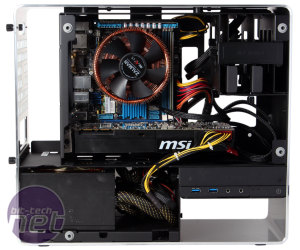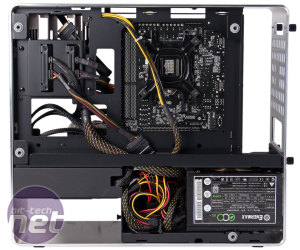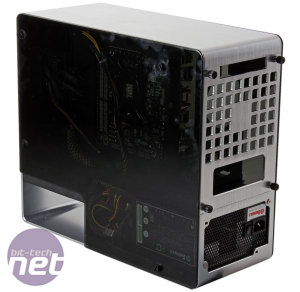
Performance Analysis
The 901's aluminium construction means that it's naturally good at dissipating heat, and indeed you'll feel the case heating up under load. Even so, it isn't designed to be used passively, and without fans there simply isn't enough airflow to handle an overclocked CPU, as our Core i5-2500K reached its Tj Max temperature and began to throttle, hence the very high delta T of 77°C. Therefore, unless you're running a stock speed CPU with a very effective cooler, we'd strongly recommend against using the case without adding in some fans, and even then we'd personally be reluctant to do so.The GPU, however, didn't suffer as much. Its delta T result of 65°C is admittedly still the highest we've seen from this test set-up, but only by 2°C. The natural inlet in the case's cutaway section is close to where our graphics card's intake fan is, so the GPU is still able to keep itself within a safe operating temperature without throttling.
Adding fans isn't something we often do to case's, as it adds too many variables when it comes to comparing cases. However, we grabbed a couple of fans we had lying around to give us at least an indication of the difference they make in the 901 and weren't disappointed. For starters, the CPU no longer throttled itself, and reached a much more respectable maximum delta T of 54°C – still only mid-league but a big improvement from what are not particularly high airflow fans. The GPU, however, goes from having the warmest delta T to having the coolest (44°C), bettering the passive result by a whole 21°C when the 120mm fan slot is filled. This fan is essentially right next to the intake area of your typical graphics card, so this isn't a massive surprise, but again we didn't use a particularly fast fan, so there's definitely leeway to install quiet models here and still be in the clear.
As you might imagine, noise isn't contained too well by the 901's glass panels, so you'll definitely want to opt for quiet coolers on your hardware as well as quiet case fans. A noisy system will quickly begin to leave a sour taste in the mouth, no matter how good it might look.
Conclusion
With an asking price of £150, the In-Win 901 is undoubtedly a very expensive mini-ITX case, and it won't win any awards in the value department, especially as in reality you're looking at £170-£180 with a couple of decent fans thrown in as well. However, the aluminium and glass combination works even better in this form factor, and the 901 excels in the design department. Not only does it look fantastic (as we said about the 904, it closer resembles a scratch-built PC from our forums than your standard case), but it's built like a tank, with the thick aluminium shell and thinner aluminium interior adding a premium feeling that's rarely found in the case market, even in cases from the likes of Lian Li and SilverStone.It's not all form over function either, as despite the bold design the 901 actually proved remarkably easy to work with. The motherboard and PSU areas are spacious, and the EZ Swap connectors on the ODD drive and internal drive bays, as well as the removable SSD trays and 120mm fan tray, make getting the rest of your components in place easy as well. In terms of cooling, you'll certainly want to add fans, but once you do your GPU will be well looked after and your CPU won't suffer too much either.
Of course, the 901 isn't without its issues, and many of them carry over from the 904, such as the awkward optical drive positioning, the lack of water-cooling support (at least that anyone is likely to use) and the low CPU cooler clearance, though this is admittedly less of an issue with a mini-ITX system. The case's inability to suppress noise that effectively also makes it annoying that anti-vibration mounts aren't included anywhere. Cable management can also be tricky, and with the glass panels everything is on show, so this is something you'll really want to get right.
Nevertheless, with the right cables and some time and attention, we're sure that some truly awesome looking builds in the 901 will make themselves known soon enough and if money wasn't an object, we're pretty sure that any small form factor fan would own one. It would be the centerpiece of any system, regardless of what hardware you put inside. In fact, if we were to own one, we'd probably want to commit heresy and buy hardware to suit the case - not the other way around, just to make it look awesome. As such the 901 is one of those rare products that's deserving of our Extreme Ultra Award.

-
Cooling22 / 30
-
Features15 / 20
-
Design26 / 30
-
Value13 / 20


MSI MPG Velox 100R Chassis Review
October 14 2021 | 15:04












Want to comment? Please log in.